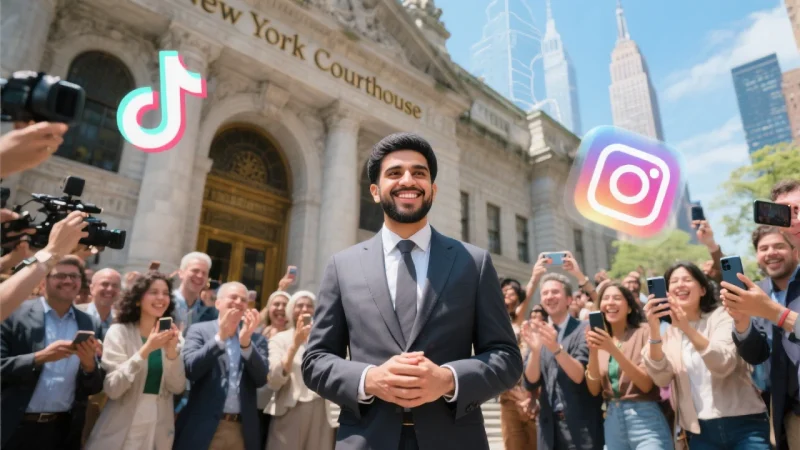
The Collision of Old vs New Political Attention
The 2025 Democratic primary for New York City mayor was more than a contest between two candidates; it was a clash between two fundamentally different theories of political attention.
On one side stood Andrew Cuomo, a political heavyweight with a massive super PAC, relying on traditional, big-money TV advertising. On the other was Zohran Mamdani, a 33-year-old Muslim socialist assemblyman, who ran a campaign that was not just unconventional in its ideology, but revolutionary in its use of social media.
The Power of Viral, Native Content
Mamdani’s campaign was the first in New York and arguably in American politics, to be truly native to the era of short-form, algorithm-driven video. While Cuomo’s ads saturated the airwaves, Mamdani’s face, voice, and message dominated the vertical feeds of Instagram and TikTok. If you were a New Yorker even tangentially interested in politics, you couldn’t avoid his content.
What set Mamdani apart was not just his use of social media, but his mastery of its language. He didn’t just post videos; he created content that felt organic to the platforms. He adopted the “man-on-the-street” genre, asking real New Yorkers about their struggles and hopes, and then listening turning the act of listening itself into a form of broadcasting. This approach was both authentic and highly effective, making viewers feel seen and heard, rather than lectured.
Charisma Meets the Algorithm
Mamdani’s charisma was a crucial ingredient. As Chris Hayes noted, he’s a “very talented communicator” with a “great smile” and a strong visual presence. But charisma alone isn’t enough; what made Mamdani’s campaign so potent was the perfect pairing of his personal magnetism with the mechanics of modern social media. His videos were visually striking, consistently branded, and emotionally resonant. The campaign’s graphic design, color palette, and even the use of filters were carefully curated, often drawing on the filmmaking expertise of his mother.

This wasn’t just about being “good on camera.” Mamdani understood the algorithmic logic of TikTok and Instagram: content had to be visually engaging, quickly digestible, and, above all, shareable.
His campaign didn’t just reach people,it spread, organically, through networks of friends and followers, bypassing the traditional gatekeepers of political communication.
The Limits of Old-School Campaigning
Cuomo’s campaign, by contrast, was a case study in the limits of old-school political strategy. Despite spending tens of millions on TV ads, he failed to break through in the new attention economy. As Klein and Hayes observed, the old formula: raise money, buy TV time, dominate the airwaves—simply didn’t work. In the world of algorithmic feeds, attention can’t be bought; it has to be earned.
This shift has profound implications for how parties choose candidates. For decades, the ability to raise money was the primary test. Now, the ability to generate attention—especially on digital platforms—may be just as important, if not more so.
Listening as a Political Act
One of the most innovative aspects of Mamdani’s campaign was his use of listening as a form of political communication. Rather than simply broadcasting his platform, he engaged with voters’ real concerns affordability, rent, child care, public transit and responded in real time. This approach not only made his campaign feel more authentic, but also allowed him to tap into the zeitgeist of a city struggling with rising costs and economic anxiety.
His policies—rent freezes, free buses, universal child care, public grocery stores—were simple, memorable, and mimetic. They cut through the noise, offering clear, tangible solutions to everyday problems. In the age of memes, simplicity and emotional resonance matter as much as policy detail.
The Role of Identity and Coalition-Building
Mamdani’s identity as a Muslim socialist was both a challenge and an asset. In a city as diverse as New York, his background allowed him to connect with a wide range of voters, especially in racially and ethnically mixed neighborhoods. Data from the primary showed that Mamdani performed best in precincts with high levels of racial integration, suggesting that his coalition was built on the city’s diversity.
At the same time, his outsider status and fresh-faced energy contrasted sharply with Cuomo’s scandal-ridden, establishment image. For many voters, Mamdani represented not just a new set of policies, but a new kind of politics one that was more inclusive, more responsive, and more in tune with the realities of 21st-century life.
Lessons for the Future
Mamdani’s victory is a wake-up call for political strategists everywhere. In the new media environment, attention is the most valuable currency, and the skills required to earn it are different from those that dominated the TV era. Charisma, authenticity, and a native understanding of digital platforms are now essential.
But there are limits. As Klein and Hayes noted, the real test will come in governing. Can Mamdani deliver on his ambitious promises in the face of fiscal and political constraints? Will his coalition hold together when the realities of power set in? These questions remain open.
What’s clear is that the old rules no longer apply. The future belongs to those who can not only articulate bold ideas, but also capture and hold the attention of a fragmented, distracted, and digitally connected electorate.
Zohran Mamdani’s win was not just a triumph of ideology or identity, but of a new kind of political communication. By mastering the language of social media, he was able to reach, engage, and mobilize voters in ways that traditional campaigns could not. His story is a case study in how the tools of the digital age are reshaping democracy itself.
